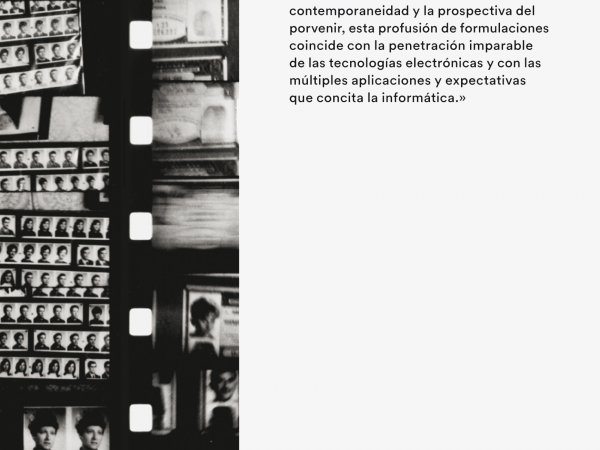Summer Readings
A selection of texts by Lisa Le Feuvre, Katarina Pierre, Hèctor Parra, Tom McCarthy, Eugeni Bonet, Hans Magnus Enzensberger, Angela McRobbie, Josep M. Martí Font, Georges Didi-Hubermann and Paul B. Preciado.
Lisa Le Feuvre and Katarina Pierre: Dentro / Fuera
Lisa Le Feuvre and Katarina Pierre, curators of the exhibition Nancy Holt / Inside Outside at the Bildmuseet in Umeå, Sweden, in 2022, held a discussion in the autumn of 2021 about the work of Nancy Holt in relation to time, location and cultural peremptoriness. The discussion has been reformulated and adapted to this publication.
Hèctor Parra: From Creative Energy to the Conformation of a Sculptural Spacetime: Musical Tension in the Work of Jaume Plensa
'Because a creative mind is a mind that listens and embraces with pain and suffering, but also with pleasure, the conflicts and the internal contradictions characteristic of the tragic condition inherent to our species.'
Tom McCarthy: What the Thunder Said. Four Short Meditations in which Christian Marclay Is Not Mentioned Once
'Tablets get shattered; things get reassembled differently, all lines remade. That is both the law’s undoing and the law.'
'For William Burroughs, language was a virus; for Kathy Acker, it was something cut into your body – for both, something also you can hack and recombine to crash the control systems of the earth.'
'Words as weapons.'
Hans Magnus Enzensberger: Absolute Emptiness. The Null-Medium, or Why all Complaints about Television are Irrelevant
'In them the media user appears, fundamentally, as a defenceless victim, and the programmer, on the other hand, as a cunning perpetrator. '
'When our concentration reaches its maximum – and this is stated impeccably in esoteric paperbacks – it is indistinguishable from the absence of mind, from a blackout, and vice versa: extreme diversion switches over to hypnotic immersion.'
Eugeni Bonet: La pantalla bien servida: la nutrición audiovisual
«Los ritos de la mesa son también un pretexto para abordar las relaciones humanas, sea en una escala íntima, familiar o coral.»
«La cultura del bienestar y de la abundancia, con todas las desigualdades y vilezas que subsisten, delimita por tanto la ebullición mundana de los motivos alimenticios en una pluralidad de expresiones de creación y consumo ocioso.»
«Los hábitos y conflictos de la nutrición, trasuntando los más amplios de la vida en sus escenarios cotidianos, llevan a la pantalla las emociones, cavilaciones y transgresiones que rodean a la fisiología del paladar y su proyección social, cultural y estética.»
[Available in Spanish]
Angela McRobbie: Industria cultural
«El trabajo creativo parece actuar, tal como sucedía en el pasado, aunque fuera solo para unos cuantos escogidos, como válvula de escape del tedio y la monotonía del trabajo normal y corriente.»
«Nadie puede permitirse el lujo de aparentar que no es excepcional, que no es muy trabajador, que no tiene un auténtico talento.»
«El índice de visibilidad del éxito ha dado auge a la invisibilidad del fracaso; las personas sencillamente desaparecen del escenario en el que estaban.»
[Available in Spanish]
Josep M. Martí Font: The American making of Miralda, the participatory artist
'The city bubbles with initiatives, breathes freedom, and lives with the sensation that anything is possible and that there are no red lines that cannot be crossed.'
Georges Didi-Hubermann: Pobles exposats, pobles figurants
«El problema es planteja encara avui: ¿com es pot filmar dignament els que no tenen nom, els que d’entrada no tenen cap altra veu que la del crit del sofriment o de la revolta? ¿Com és possible acostar-se als no-actors, mirar-los als ulls, escoltar-ne les paraules i respectar-ne els gestos?»
[Available in Catalan]
Paul Preciado: The phantom limb. Carol Rama and the history of art' in the publication 'The passion according to Carol Rama'
'The work of Carol Rama couldn't have been seen in its moment: the frame of intelligibility through which to see her work simply did not exist.'
'It is necessary to defeminise, defolkloricise, defetishise, depathologise and depornographise Carol Rama.'
'Throughout the nineties, when Carol Rama sought a place of identification, the artist refrained from appealing to figures of femininity and instead explored the figure of the animal infected with bovine spongiform encephalopathy: mad cow disease.'
'The mad cow is me, and this has given me a joy, an extraordinary joy.'







![Quaderns portàtils 25. Pobles exposats, pobles figurants [Publicació]](https://img.macba.cat/public/styles/large/public/imagenes/archivo/documento_archivo_A.HIS.02735.jpg?itok=YV8G5DpM×tamp=1577062121)
